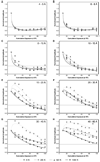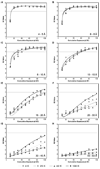Radiation damage effects at four specimen temperatures from 4 to 100 K
- PMID: 19903530
- PMCID: PMC2826528
- DOI: 10.1016/j.jsb.2009.11.001
Radiation damage effects at four specimen temperatures from 4 to 100 K
Abstract
Radiation damage is the primary factor that limits resolution in electron cryo-microscopy (cryo-EM) of frozen-hydrated biological samples. Negative effects of radiation damage are attenuated by cooling specimens to cryogenic temperatures using liquid nitrogen or liquid helium. We have examined the relationship between specimen temperature and radiation damage across a broad spectrum of resolution by analyzing images of frozen-hydrated catalase crystal at four specimen temperatures: 4, 25, 42, and 100K. For each temperature, "exposure series" were collected consisting of consecutive images of the same area of sample, each with 10 e(-)/A(2) exposure per image. Radiation damage effects were evaluated by examining the correlation between cumulative exposure and normalized amplitudes or IQ values of Bragg peaks across a broad range of resolution (4.0-173.5A). Results indicate that for sub-nanometer resolution, liquid nitrogen specimen temperature (100K) provides the most consistent high-quality data while yielding statistically equivalent protection from radiation damage compared to the three lower temperatures. At lower resolution, suitable for tomography, intermediate temperatures (25 or 42K) may provide a modest improvement in cryo-protection without introducing deleterious effects evident at 4 K.
(c) 2009 Elsevier Inc. All rights reserved.
Figures








References
-
- Ludtke SJ, Baker ML, Chen DH, Song JL, Chuang DT, Chiu W. De novo backbone trace of groel from single particle electron cryomicroscopy. Structure. 2008;16:441–448. - PubMed
-
- Jiang W, Baker ML, Jakana J, Weigele PR, King J, Chiu W. Backbone structure of the infectious ε15 virus capsid revealed by electron cryomicroscopy. Nature. 2008;451:1130–1134. - PubMed
Publication types
MeSH terms
Substances
Grants and funding
LinkOut - more resources
Full Text Sources

